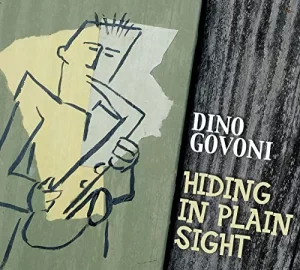 Tenor saxophonist and Berklee College of Music professor Dino Govoni stirs the soul while also impressing the listener with stirring melodic phrases that only the best horn players in jazz can build. On Govoni’s latest album, Hiding In Plain Sight, his mellifluous sax is aided and abetted by horn player Alex Sipiagin, pianist Henry Hey, bass player Michael Pope, and drummer Jeff “Tain” Watts. As can be heard on this release from the Whaling City Sound label, these five are capable of coming out of nowhere then suddenly having the listener engaged with a smoking hot melodious tone played at a dizzying pace.
Tenor saxophonist and Berklee College of Music professor Dino Govoni stirs the soul while also impressing the listener with stirring melodic phrases that only the best horn players in jazz can build. On Govoni’s latest album, Hiding In Plain Sight, his mellifluous sax is aided and abetted by horn player Alex Sipiagin, pianist Henry Hey, bass player Michael Pope, and drummer Jeff “Tain” Watts. As can be heard on this release from the Whaling City Sound label, these five are capable of coming out of nowhere then suddenly having the listener engaged with a smoking hot melodious tone played at a dizzying pace.
Four compositions on this album were composed by Paul Nagel. The roller coaster of hot, smoky, and sultry jazz on Hiding In Plain Sight begins with the eruptive fiber of Nagel’s “Stories Passed.” With a thick low end beneath him and a sparkle of piano sprinkle beside him, Govoni hints at the dynamite to come with thick tenor sax lines, pausing them enough to suggest something more is in the offing. Meanwhile, this lets his bandmates up the ante with shiny piano tinkling and a pliant rhythm section. Soon, though, Govoni’s tenor sax lines are moving in restless intervals, festive, feeling full, like he’s playing three saxes at once. His speed and dexterity of flight amazes as the listeners witnesses brilliant skill and feels motions of soul. It’s the way the tenor sax suggests and then delivers makes this composition a thrill. Its structure, upheld by each player, makes it art.
“Cobalt,” composed by Henry Hey, makes its airy soulfulness become more palpable. Light, loose drum fills and subtle toned bass provide a serious allure. Govoni plays a tap dancing melodic line, one that skitters along loosely, playfully. Yet, that main melodic line, punctuated by a bopping piano line, soon turns into a mad dance. Its phrasing, sudden and clever, moves faster than the rumbling groove and the contrast brings out a cool vibe. Darting in and around Hey’s splashy piano notes creates a whirlwind. One can picture a lot of coolly sophisticated people gathered at the jazz bar or speakeasy, and, setting a vibrant, three dimensional scene is another of this combo’s strengths.
A peculiar mood piece, “Falling Ahead” finds Govoni and trumpet player Alex Sipiagin engaging in a light dance, an exchange of something intangible, each playing off the main melody line. Other treats for the ear, soul, and imagination comes in the form of Michael Pope’s elastic pops on his bass guitar, a low end line that pokes at the listener with slightly accented notes. Sprinkle in some forlorn Henry Hey dewy piano notes and we are inside of an amazing sonic landscape.
Spirited, Hal Crook’s “Thinker’s Anonymous” sprints right in, pretty piano notes over a grooving rhythm section. That initial rhythm becomes a playground for the two horns. Sipiagin puffs out a dazzling spiral of notes, reaching up for a greater feeling of freedom with each interval, until his trumpet is screaming out its loose joy. Govoni blows his own masterful circular phrase, ascending to ever wider intervals of expression. The two horns eventually turn their phrases into a mad dance of ecstatic sound. The piano joins the rhythm section in a galloping movement, Sipiagin and Govoni amaze with speed and fearlessness, two players unafraid to takes risks to arrive at such a lively, challenging piece.
The down tempo sultriness of “Ask Again” turns a floating dream cloud of horn into a romantic setting. There is a lot of tender feelings packed into the mellow expression of how these lines are drawn. Intervals of easygoing horn suggest the anticipation of an even greater event to come. With eloquent piano tinkling and sensitive touches of low end below the main melodic theme, the horn is buffered by a second sensitive line. Each player exudes enough feeling to suggest someone is in love.
“Sublimate,” another composed by Hey, finds the three upper register players playing their various takes on melody line that is anything but sublimated. This peppy, upbeat piece finds Henry Hey tapping out a lively piano melody, one which begins with a well paced, clever tone of urgency. Eventually, Alex Sipiagin blows a windy storm of trumpet melody, as intervals get briefer his line thickens, impressing with it tone.
“Point Turn” is cool breezy jazz at its finest. Govoni’s sax line tap dances in hip waves around a fibrous groove and alongside a sophisticated piano line, a line loaded with dark tones that contrast well with a flighty of fancy tenor sax. Jeff “Tain” Watts serves up a broth of pulpy drum fills, each one punchy and full. Michael Pope’s elastic bass phrasing serves as a consistent platform to all of the busy fun happening above. It’s the way the combo throws so much pulsing instrumentation into the broth of sound that makes this a spicy, simmering piece, moving the listener to every detail.
“Appels To Apples” features the combo playing more of their cool jazz style. Here, the instruments stretch out into sprawling expressions. The tenor sax, wafting breezily, reaching upwards in every higher expressions of joy. The upright bass flexibly expresses its own kind of freedom, reaching beyond the lower register into sweeter notes. That is probably because the combo’s bass player, Michael Pope, composed this one. There is an interval of spiraling piano notes as well, like the ivories were riding the crest of the low end notes. This piece works well because of how each player injects a lot of hip, swinging action that mirror each other while also trailing off with individual distinctions.
Close out track “Edge Walker,” Govoni’s only composition here, leaves us with a friendly farewell for now. Lofty, just above a sublimated rhythm section, a beautiful trumpet melody sails through the piece. Eventually, this close out track finds the horns blowing more intricate line, in unison, and then in fanciful solo phrases. Followed by an energetic rhythm section, the horns expand into an even wider, warmer mode of expression. The beauty of this piece lies in how well the entire combo combines. The song title likely was inspired by how Govoni skates along that warm surface with an edgy sax line that feels and sounds inspired by the wilder forms of American jazz from the 1940s, namely Bebop. It’s a successful contrast to the wider swing in the song.
Dino Govoni concocts masterful arrangements on this Hiding In Plain Sight album. He works well at setting a scene and creating a vibe for a song. He and his cohorts slyly inject enough tone into each piece to give it its own personality and its own setting. Govoni and his band mates are all fantastically disciplined on their instruments, each possessing strong ability to impact the vibe, tone, and direction of a piece.

